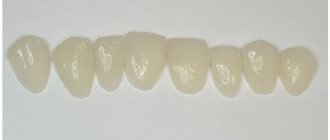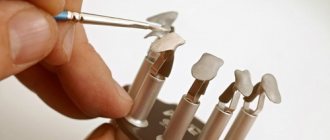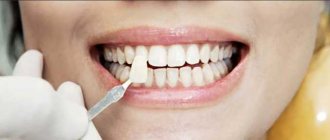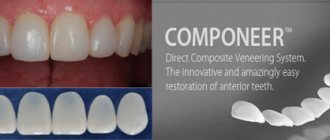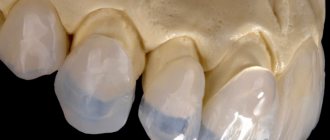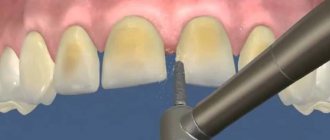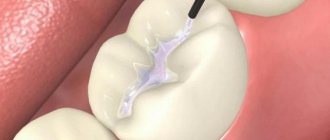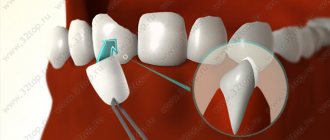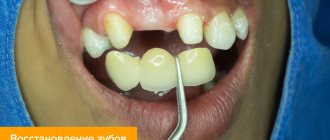From this article you will learn:
- what are veneers in dentistry,
- before and after photos, patient reviews,
- veneers – price for 1 tooth in Moscow (for 2021).
Veneers are microprostheses made of ceramic or composite filling material (in the form of thin plates) that cover the front surface of the teeth. The thickness of standard ceramic veneers starts from 0.6 mm, respectively, and the front surface of the tooth must be ground to the same depth (Fig. 1-3). However, in dentistry there are also so-called “thin veneers” - they are made from Emax glass ceramics. They have a thickness of 0.3-0.4 mm, which in some cases makes it possible to do without tooth preparation.
To complete the picture, it should be noted that there are also so-called ultra-thin veneers for the front teeth, which are produced by DenMat under the brand Lumineers® (Lumineers). The advertisement states that their thickness is only 0.2 mm, which is guaranteed to allow you to avoid grinding off the surface layer of tooth enamel. But this is not entirely true, and the original manufacturer's instructions already clearly indicate that the thickness of the lumineers will be from 0.3 to 0.7 mm (i.e. they will not be thinner than Emax).
What are dental veneers: photo
Correcting teeth with veneers allows you to improve their color and shape, allows you to change the inclination and position in the dentition, and also makes it possible to eliminate wide interdental spaces. Veneers are either “direct” (composite) or “indirect” (orthopedic). Composite veneers are made by dentists from ordinary composite filling material. They cost much less, and their aesthetics and service life are noticeably more modest - compared to higher quality indirect ceramic veneers.
In turn, orthopedic indirect veneers are made in a dental laboratory - mainly from various types of ceramics. The most common types of ceramics used to make veneers are porcelain, lithium disilicate, or zirconium dioxide. It is for such ceramic veneers that patient reviews will be as positive as possible, because... they really allow you to achieve excellent dental aesthetics (which can be seen in Hollywood stars). How much does it cost to install ceramic veneers? Read below.
Important: but patients are faced not only with the problem of choosing between ceramic and composite veneers (here it all comes down to budget). It becomes more difficult when the patient learns that ceramic veneers can be made not only from different types of ceramics, but there are also different technologies for their manufacture - the layer-by-layer ceramic application method, injection molding technique or CAD/CAM technology. And this also affects aesthetics and their service life.
What kind of design is this and its features
What kind of dentures are these and how are removable dentures different from all the others? Removable veneers are veneers that can be removed. It would seem nothing complicated. But in this simplicity lies either an advertising ploy - it misleads patients, or such veneers will soon have to be replaced with permanent ones - which in theory they should be.
It is worth saying that not a single self-respecting orthopedic dentist will offer a patient removable “veneers” as an option to improve the aesthetics of a smile. What's the point here? In general, veneers1 are non-removable microprostheses - overlay plates on the upper and lower front teeth, which make them more beautiful in shape and shade. But such onlays are made in a dental laboratory (this is important!) within a few days or weeks. During this time, the patient is given temporary plates - composite or plastic, which will soon be removed. They are needed to protect the ground teeth from damage and temporarily give them a natural look.
Those removable veneers that are offered to patients on websites on the Internet or in advertising videos and booklets are most often similar to conventional silicone dentures for the entire jaw. They also resemble the joke “jaws” that people wear to masquerades, and even chewing gum in the shape of jaws. They attach very poorly to the mouth and, according to patients, they are completely impossible to wear. You can see how “natural and natural” such products look before and after installation - see the photo.
Features of cosmetic restoration on the lower incisors
The lower incisors are the smallest teeth, which, nevertheless, play an important role as a cutting tool when biting food. Therefore, they are susceptible to destruction to no less extent than the upper ones, especially along the cutting edge. They require cosmetic restoration, which has several features:
- The lower incisors often become crowded due to underdevelopment of the lower jaw or displacement of the chewing teeth. This makes it difficult to prepare teeth and install veneers.
- The anatomical proximity of the outlet openings of the sublingual and submandibular salivary glands to the lower incisors causes the deposition of tartar on their surface. Careful removal of stone and restoration of the gingival margin is required.
- During atrophic processes in the periodontium, the roots of the lower incisors quickly become exposed, visually lengthening the teeth. And then the incisors are the first to become loose and fall out. The need to make veneers is explained by their displacement.
To prevent veneers from chipping when biting food, microprostheses for the lower jaw are created with the obligatory overlap of the cutting edge. Overlapping is also necessary to align the cutting edge, which is noticeable when smiling and talking.
Types of removable “veneers”
This group includes the following types of structures (although not all of them have the right to be called veneers):
- temporary onlays for teeth: patients wear them for about 2 weeks or more - up to 2 months. During this time, permanent onlays are made in the laboratory from ceramics, zirconium dioxide, and ceramic composite. Moreover, for both temporary and permanent overlays, the rule applies - each tooth has its own individual veneer, made from impressions,
- DenMat's Snap-On Smile Dentures: These are temporary dentures that look like veneers or crowns bonded together. They can be worn over the entire dentition or on a “problem” sector. Snap-On Smile not only improves the aesthetics of a smile, but can replace several missing teeth in a row. They are made individually from impressions sent to the manufacturer’s laboratory in the USA,
- removable “veneers” on teeth, “dental onlays” or “false teeth”, which can be purchased on the Internet, pharmacies or cosmetics stores: they look like a silicone prosthesis for the entire row, or single onlays that are glued at home yourself.
As for the last variety, there is no talk here of any individualized approach or taking casts. These “dentures” have a standard shape and are suitable for a person with perfectly straight teeth. But in any case, they will not stick well and will come off with a little pressure. So with such a “Hollywood smile” you can only smile (but even this is not a fact), but you won’t be able to chew food.
Zirconium dioxide crown on an implant for the whole 70,000 rubles.
OSSTEM implant (South Korea), individual zirconium abutment, gum former, impression taking.
Creation of a Prettau zirconium crown using 3D modeling technology. Consultation with 2 doctors: an orthopedist and an implantologist for free! Call now or request a call
Opening hours: 24 hours a day - seven days a week
Indications
The lower front teeth require aesthetic prosthetics if:
- cutting edges are destroyed;
- there is crowding of teeth in the anterior section;
- the incisors have an irregular shape;
- the color of the teeth leaves much to be desired;
- cracks or chips are visible on the enamel;
- one or more incisors deviate from the general line of the dentition.
It is difficult to use full-fledged crowns to restore aesthetics due to the small size of the lower incisors, which do not allow the necessary grinding. Veneers can help out.
What materials are they made from?
Overlay removable veneers are made of polymers, silicone, polypropylene, and plastic in light shades. These are inexpensive materials, they are easy to process and can be easily painted in enamel colors. But we must understand that even in professional dentistry such materials are used only on a temporary basis, because they have low performance characteristics. The materials are softer and more fragile than those used for real microprostheses. They also have irregularities and pores on the surface, into which dietary fiber and dyes become clogged.
How veneers differ from crowns and composite restorations
Veneers, crowns and composite restorations solve various dental problems:
- Veneers are designed to improve the appearance of teeth. With their help, you can get straight teeth in a few days, sometimes in one visit to an orthopedic dentist, and hide visual defects - unsightly color, darkened fillings, crookedness.
- The purpose of a crown is to protect the tooth from destruction. Typically, crowns are placed on teeth after root canal treatment and nerve removal. After opening the cavity due to pulpitis, periodontitis or caries, the tooth becomes more vulnerable and is destroyed faster. To preserve it, the surface is completely covered with a crown.
- Composite restoration is the restoration of the shape of a partially destroyed tooth using filling materials. For example, when part of the crown broke off or the doctor had to remove enamel and dentin in a significant area due to severe caries damage.
Let’s summarize the differences: with the help of veneers, visual defects are eliminated, crowns are necessary to protect teeth from destruction, and composite restoration is used to restore damaged teeth.
Advantages and disadvantages
The advantages or benefits, if you can call them that, are that for not very much money you can get a new look for some kind of masquerade or photo shoot. Then there are the disadvantages, which are mentioned by reviews from dentists and people who decide to buy removable dental veneers. The disadvantages of removable dental veneers are as follows:
- poor fixation in the oral cavity,
- the risk of getting into an awkward situation in society,
- not very aesthetic appearance,
- rapid coloring of lining materials with food coloring, tobacco smoke, etc.,
- discomfort when wearing: such pads are made according to a template, so they will be uncomfortable after installation. After all, absolutely every person has their own individual parameters for the shape and inclination of their teeth, their sizes - it is impossible to measure everyone with one “ruler”,
- unpleasant “chemical” smell or taste from materials,
- risk of complications: damaged enamel, pulpitis, injuries to teeth and gums, chemical and thermal burns, allergic reactions to materials, risk of choking on a peeling pad or swallowing remaining adhesive.
“I placed an order in one group and was led by praise and a large audience. And I was very pleased with the price - it was only 500 rubles, to be honest. But on the day I received it, it turns out I was added to the blacklist. And I couldn’t leave my not at all positive review. These turned out to be not veneers at all, but some kind of toys, just to scare children with them. They do not stick to the teeth and fall out constantly. In general, horror!!!"
Marina_99, review from the woman.ru forum
Installation
The production and installation of overlays takes place in 2 visits to a specialist. The first step is to prepare the damaged unit. The patient comes back for the second time approximately 14 days later for installation of a permanent veneer.
The procedure takes place in the established sequence:
- Preparation of a defective tooth . If there is a seal placed on it a long time ago, it must be replaced with a new one. Such manipulation increases the “adhesion” of the veneer at the point of contact with the filling.
- Color selection. Based on the dental shade scale, the color of the manufactured attachment is selected that is suitable for all units.
- Preparation. A layer equal to the thickness of the veneer is sanded off from the outer surface of the enamel - approximately 0.5-0.7 mm (in some cases, the size of the removed layer increases to 1.5 mm).
- Making a cast . For this purpose, paste-like impression material is used. Using a dental spoon, it is placed on the tooth and remains there until it hardens. Afterwards, the paste with the tooth imprint is carefully removed and sent to the laboratory to cast a plaster model.
- Setting up a temporary overlay . After removing a layer from the enamel, its sensitivity increases greatly, and the surface becomes rough with protrusions. To eliminate discomfort, the patient is given temporary plastic veneers while the permanent veneers are being made. They are made immediately upon the 1st visit.
- Installation of permanent overlay . The completed model is assessed by the correct selection of shade, shape and tightness. If there are deficiencies, the veneer is sent for rework. Only after it perfectly covers the tooth and fits all parameters, the doctor begins the last stage - installation.
The nozzle is fixed in a permanent place with cement dental mass. Before fixing, it is treated from the inside with a special gel. It gives the surface roughness and increases the degree of its adhesion to the tooth. After applying the cement, the veneer is fixed to the prepared unit, and the solution that is squeezed out is removed with special tools.
Veneering is a painless procedure and in some cases is preferable to bleaching, restoration and other methods.
We invite you to read reviews about teeth whitening with hydrogen peroxide in a specially prepared article. Don’t know how to choose the best travel oral irrigator? Studying the following review will help you understand this issue.
By following this link: https://dentist-pro.ru/krasota-i-uxod/sredstva/zubnye-pasty/rocs-otzyvy.html - you can read reviews about Rox toothpaste.
How to use removable veneers
How to install and remove removable “veneers” will depend on their type. If the product is in the shape of a full jaw, then they are simply put on the teeth from above and removed from them by hand. Some sellers write that you first need to put the structure in hot water for a few minutes - almost boiling water - and then put it on. But in this case, there is a real risk of burning the gums and overheating the dentinal layer (it is located under the enamel), which can provoke pulpitis. Not to mention the discomfort of the installation process - some people report that it is painful or too hot for the teeth.
Removable “veneers”, which imitate real ones in their shape (but are sold in packs of 70 pieces, and are not made individually), are supposed to be fixed with a special adhesive using a brush and tweezers. And all this on your own at home. But if dentists use only professional formulations with proven components, then it is completely unknown what will end up in the package with “veneers”. It will be good if it is harmless glue (even if it comes off quickly). And if you come across a toxic substance that is difficult to remove, you will have to urgently seek medical help.
Reviews
Gone are the days when, for some reason, a person was embarrassed by his smile. Now almost any dental defect can be corrected quickly and unnoticed by others. Veneers are the most common method of aesthetic restoration of problem areas.
You can share your impressions of using pads and your opinion about their effectiveness by leaving a comment on this article.
If you find an error, please select a piece of text and press Ctrl+Enter.
What is better to choose?
If you understand the question of which removable “veneers” are better, then the only option would be Snap-On Smile dentures. They are made individually and from quality materials. But, since the plant is located in the USA, the patient will have to wait about 1-2 months, and the main waiting time will be spent on transportation. Again, you will have to first visit an orthopedist to take impressions and sanitize the oral cavity. As a result, the final cost of treatment can be close to installing real veneers.
BEST REMOVABLE DENTURE - 20,000 rub.
All manipulations for the manufacture, installation and fitting of the prosthesis, including impressions, are included.
Save RUB 10,000! >> Call now or request a call
Opening hours: 24 hours a day - seven days a week
Contraindications
The patient will be denied installation of veneers if:
- abnormal bite;
- the 6th or 7th chewing teeth are missing;
- the lingual part (internal) is destroyed;
- a significant area of the internal part is sealed;
- extensive carious lesions, periodontitis, gingivitis or periodontal disease have been diagnosed;
- very thin (less than 0.5 mm) enamel;
- bruxism (night grinding of teeth).
Restrictions to the installation are also a person’s hobbies for extreme and contact sports, which have a high risk of injury.
Bad habits, such as constantly biting your nails, cracking nuts, opening bottles and tearing threads with your teeth, can also serve as a reason for refusal.
The presence of contraindications is determined by the dentist. If they are present, he will offer an alternative option for restoring the dental surface.
How much does a “Hollywood” smile cost?
How much do removable dental veneers cost? If you study the offers on various sites, the average price will be 1,200 rubles for a complete “transformation” of your smile. But, as practice and reviews of people who have decided to make such a change in appearance show, this is money down the drain. In reality, such products will not make your smile more beautiful, and they are impossible to wear.
If the patient is interested in the cost of temporary veneers, which need to be worn while the permanent ones are being made, then their cost, as a rule, is already included in the overall price tag. Those. there will be no additional costs. Classic non-removable ceramic onlays for teeth cost from 15 thousand rubles and more - it all depends on the cost of materials and methods of processing them. By the way, if necessary, the doctor will be able to remove them and install new ones if the need arises.
1Gurel G. Ceramic veneers, 2007.
Your questions and answers
QUESTION I bought removable veneers online, but I cannot attach them to my teeth. They fall off constantly. Tell me how to do this better? Alexandra
ANSWER Hello, Alexandra. Unfortunately, there is nothing we can do here. Because these are not veneers at all, but their imitation. Real veneers are installed in dentistry using a special adhesive composition - and remain on it for years. Also, real veneers are made based on impressions of the patient’s dentition, i.e. they are individual and precisely adjusted to the parameters of a particular person. Whereas “veneers from the Internet” are template overlays made according to standards known only to the manufacturers themselves. That's why they don't stick to the teeth. The use of any independently selected adhesives is unacceptable, as this can only harm yourself. Therefore, we do not recommend wearing these products. But you can use them for creativity, crafts - whatever your imagination allows.
Author: Nepochatykh V.V. (Thank you for your help in writing the article and the information provided)
Recommendations
High-quality veneers cannot be cheap - their production requires the use of high-quality material, the use of high-precision machines and highly qualified doctors. To become the owner of a beautiful smile, contact qualified doctors who will restore your teeth using individual impressions.
The Shifa clinic employs dentists with extensive experience who have received practice in the world's best dental centers. Specialists regularly take advanced training courses and attend seminars on advanced dental technologies and keep up with the latest advances in the field of dental prosthetics. And the latest equipment, combined with computer modeling of the future smile at Shifa, allows you to recreate aesthetic and durable veneers for the lower teeth down to the smallest detail. Trust your health and beauty only to professionals!
General principles of stitching
When grinding for veneers, the orthopedic dentist is guided by the minimum need, as well as the condition of the tooth itself on which the inlay is installed. This is due to the fact that a high-quality connection between the plate and the stump is possible only in the presence of tooth enamel, which is why it is so important to preserve it.
But it will also not be possible to keep it completely intact, since the artificial element has its own thickness, which increases the size of the tooth, and the connection in this case will be unreliable.
Preparing teeth for veneers provides the following effects:
- fixes the plate efficiently;
- masks the connection point;
- maximizes service life;
- reduces the risk of damage to the product.
Installation of artificial elements can be done without turning, but, as a rule, such prosthetics are carried out to eliminate any minor cosmetic defects and such a prosthesis will not last for a long time. That is why the vast majority of dentists first fully process the tooth enamel and only then fix the plates.
Installation principle
Modern onlays - lumineers and ultraneers - do not require preparation. To install them, you only need to roughen the enamel. But they also cost an order of magnitude more.
